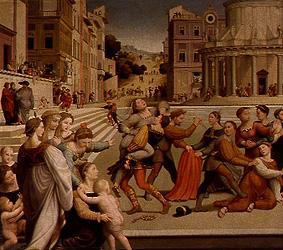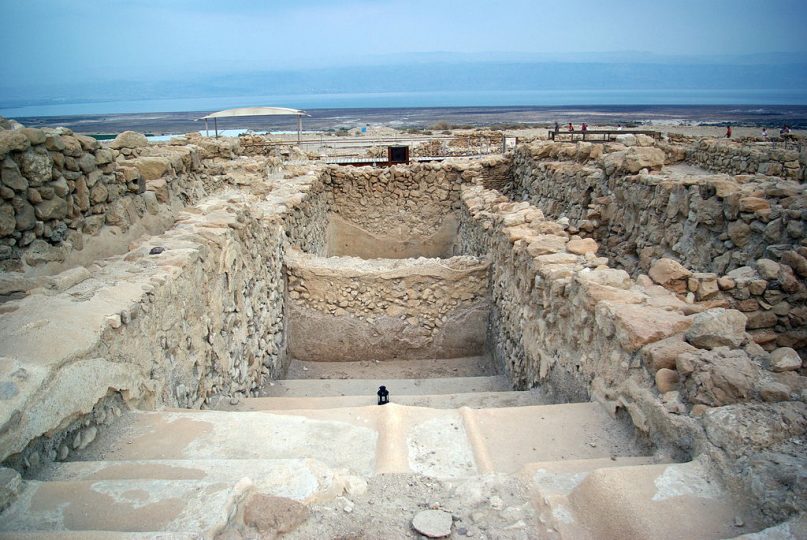(RNS) Trapdoors, secret chambers and mysterious torch-lit beach rituals. The eighth episode of “Dig,” the Holy Land conspiracy thriller that aired Thursday (April 23) on the USA Network, serves up all these classic elements of suspense.
But that heady cocktail comes with a shot of religious history and biblical references that add context to what is already a complex plot involving cloned high priests, murderous rabbis and the cutest little red heifer ever genetically engineered on a Danish farm. Can you hear religion and popular culture go CRASH?
“It can’t all be crazy, though, can it?” Emma Wilson (Alison Sudol) asks the hot FBI agent on “Dig,” Peter Connelly (Jason Isaacs), as they look at end-of-the-world messages left behind by a crazed — and dead — archaeologist.
“The messenger, maybe,” Peter replies. “But not the message.”
“To a nunnery, go!”

Rape of Dinah.
Both the bad guys and the good guys descend on a nunnery belonging to a group called the Sisters of Dinah, in search of an antique plaque depicting “the revenge of Dinah.”
The fictional religious order and its equally fictional plaque are derived from the story of Dinah, the daughter of Jacob and Leah. The Book of Genesis tells how Dinah is kidnapped and raped by Shechem, a rival tribesman. Shechem then asks for Dinah’s hand and says her family can ask any “bride-price” they like from his family.
Jacob’s sons ask for their foreskins.
Shechem and his tribe are circumcised, Dinah is handed over — and three days later, while Shechem and his men are recuperating from the “surgery,” Dinah’s brothers kill them, plunder their loot and steal their sister away. The brothers tell their angry father, “Should he treat our sister as a harlot?”
There is no Catholic order of nuns called the Sisters of Dinah, but there are — as described by evil “Dig” archaeologist Ian Margrove (Richard E. Grant) — religious orders in Jerusalem that date back to the Crusades.
The Intifada
Peter and Golan (Ori Pfeffer), the two supersleuths on “Dig,” visit a university professor who tells them of his delusional colleague who wrote about a treasure hidden under the Temple Mount.
“This was 1988,” the professor says. “His paper fed into the Intifada.”
The professor is referring to the first Palestinian uprising against Israel, which started in 1987 and lasted until the early 1990s. “Intifada” is Arabic for “shaking off” and describes armed resistance by Palestinians who believe Israel wrongfully occupies their land.
During the first Intifada, a group called the Temple Mount Faithful tried to lay a cornerstone atop the Temple Mount, the home of the Al-Aqsa Mosque, one of Islam’s most sacred sites. Jews believe that the Temple Mount was where their temple once stood. Muslims believe it is the site where the Prophet Muhammad ascended to heaven.
Temple Mount Faithful resembles the fictional Jerusalem Heritage Center in “Dig” in that both groups want to see the Temple Mount under Jewish control so they can rebuild the Jewish Temple.
Qumran

A view of Qumran, Israel.
Golan goes into the desert to a site called Qumran. What, he wonders, are Rabbi Lev and his accomplices doing there?
Qumran is a real place, a series of caves on the shore of the Dead Sea. It is famously the site where the Dead Sea Scrolls were found in a jar by a couple of Bedouin shepherds in 1947.
As Emma Wilson says on “Dig,” Qumran has been inhabited several times. The oldest things found at the site date from the Iron Age — about the eighth century B.C. The Romans are believed to have destroyed the settlement there during the Jewish War of 70 A.D. — the same war chronicled by Flavius Josephus, a Jewish-Roman historian referenced in an earlier episode of “Dig.”
And who lived at Qumran? The Essenes — just as they apparently do in “Dig.” Described in the show as protectors — they are awfully handy with an automatic weapon — the real Essenes were a monastic sect. Real archaeological digs at Qumran suggest they probably numbered about 200, built a fortress-style tower and likely slept in a ring of caves around it — the same caves where the climax of this episode occurs.
But more relevant to “Dig,” Essene theology divided the world into two camps — the “sons of darkness” and the “sons of light.” Guess which one they were! And the leaders of these two camps were the “angel of darkness” and the “prince of light.” Could the “Dig” character known only as “The Essene” be this prince?
Alert the Essenes — there are only two hours of “Dig” left to find out.
YS/MG END WINSTON




